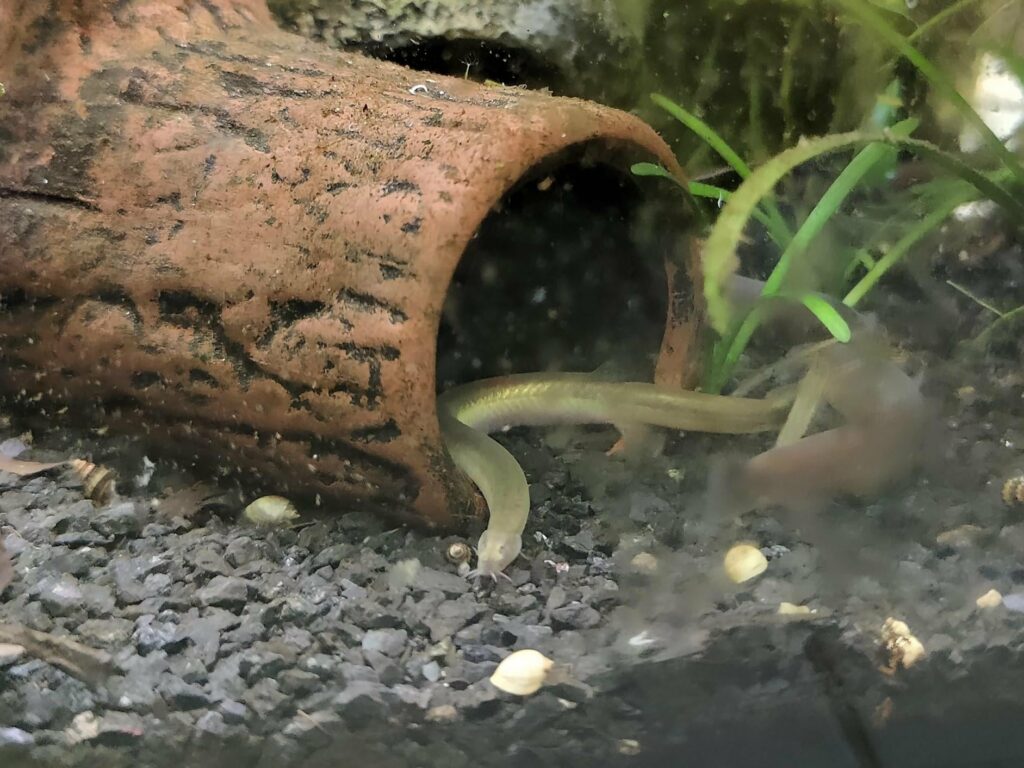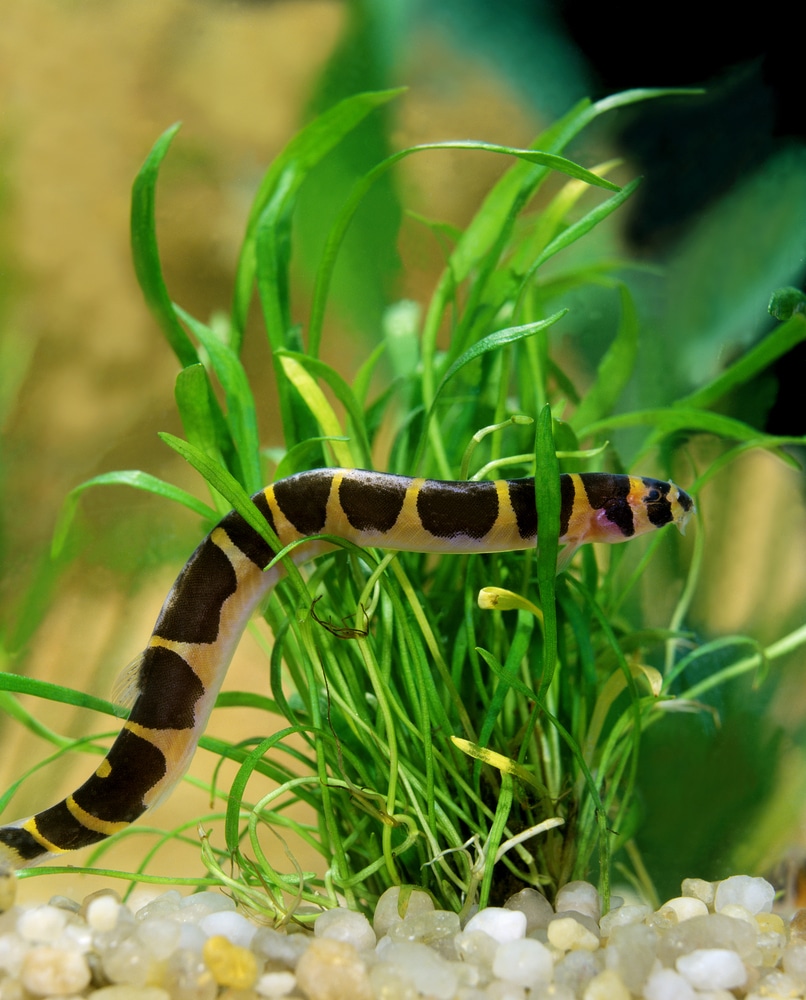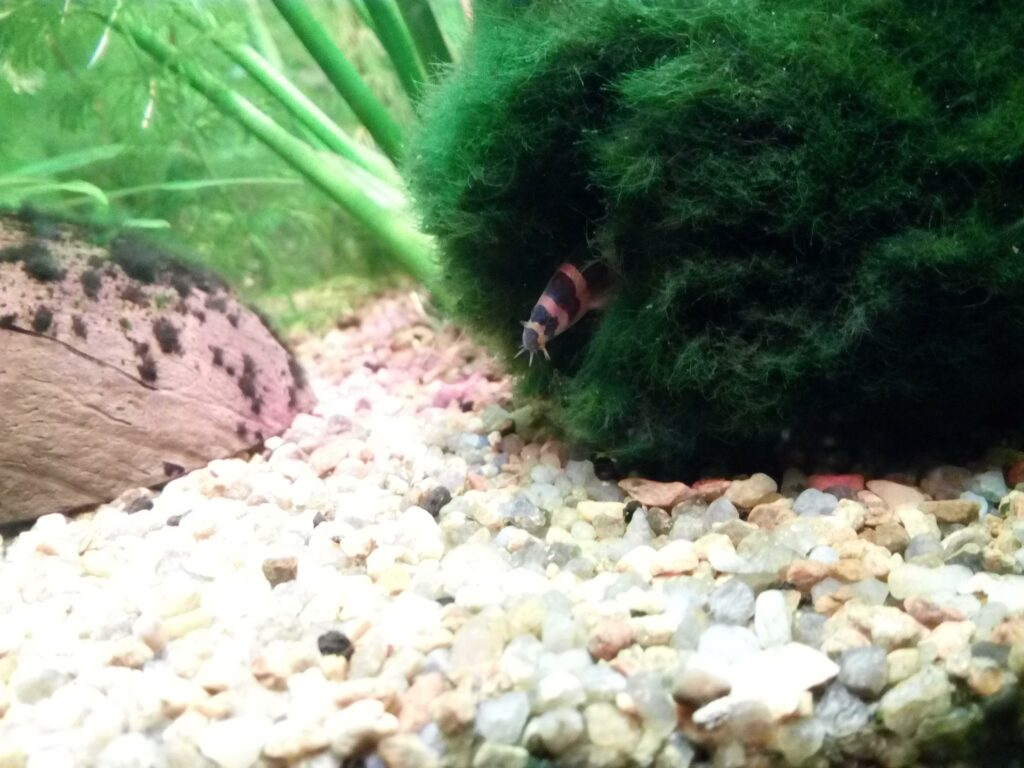Kuhli Loach (Pangio kuhlii), also known as Coolie Loach or Leopard Loach, is a popular freshwater fish species in the aquarium hobby. Belonging to the family Pangio, they are eel-like in form and have striking patterns. In this comprehensive guide, we will cover all aspects of Kuhli Loach care, including tank setup, feeding, breeding, and compatible tankmates.

Getting to Know the Kuhli Loach
Kuhli Loaches come from equatorial Southeast Asia where temperatures are continually tropical. The streams and rivers they live in are often stained brown with decaying plant matter, lowering light levels and providing plenty of silt and debris for them to sift through. Replicating this environment as closely as possible will keep them happy and out in the open more.
| Loach Species | Common Name | Size (inches) | Temperature (°F) | pH | Compatibility | Tank Size (gallons) |
|---|---|---|---|---|---|---|
| Kuhli Loach | Coolie Loach | 3-4 | 75-86 | 6.0-7.0 | Peaceful, good with small fish and snails | 20+ |
| Yoyo Loach | Pakistani Loach | 4-6 | 75-82 | 6.0-7.5 | Semi-aggressive, good with other medium to large fish | 55+ |
| Zebra Loach | Leopard Loach | 2-3 | 72-79 | 6.0-7.0 | Peaceful, good with small fish and snails | 15+ |
| Dojo Loach | Weather Loach | 10-12 | 65-75 | 6.5-7.5 | Peaceful, good with other large fish | 50+ |
| Hillstream Loach | Borneo Sucker | 3-4 | 72-79 | 6.0-7.5 | Peaceful, good with small fish and snails | 30+ |
Kuhli Loaches are great freshwater fish for beginners because they are fully grown at 4 inches and reach sexual maturity in 2 years. For such small fish, they are incredibly long-lived; 8 years is common and up to 10 years is not unheard of.
They are similar in color to another aquarium fish, the Clown Loach. However, a Kuhli Loach is much thinner and stays small. The Clown Loach is a schooling fish that grows larger than 12 inches and is only suitable for the largest tank size you can find.
Pangio kuhlii is an ideal fish for a smaller home aquarium where non-aggressive fish live. What better way to add color and activity along the bottom of the tank?
- Scientific Name: Pangio kuhlii
- Origin: Malaysia & Indonesia
- Length: 4 inches
- Aquarium Size: 10-20 Gallons
- Temperament: Peaceful
- Difficulty: Easy
Kuhli Loach Aquarium Conditions

Here is what you should know about aquarium conditions and water parameters when keeping a Kuhli Loach:
What Tank Size Do I Need?
If you only buy a single Kuhli Loach a 10-gallon aquarium is a bare minimum tank size. However, they prefer being kept in groups, making 20 gallons more comfortable. In such a spacious tank you can easily keep a group of 4 to 6 individuals, where you can watch them explore their surroundings and disappear into the substrate with ease.
Kuhli Loach Water Quality
Kuhli Loaches aren’t demanding in terms of water conditions. But the exact water parameters they prefer are soft, acidic conditions anywhere from pH 4.0 up to neutral water chemistry (pH 7.0). Cold is much more dangerous to them, however. Since they are from Indonesia and Malaysia Kuhli Loaches do need elevated tropical temperatures year-round. Remember, in the fish’s natural habitat it never grows very cold.
The temperature should never go much below 75℉. Below this range Coolie Loaches are prone to opportunistic infections like ich and body fungus. They also lose their appetites and become less active and social with each other.
- Temperature: 75-84F
- pH: 0-7.0
- General Water Hardness (GH) + Carbonate Hardness (KH): 2-10 (very soft to moderate)
The lower end of the pH, GH, and KH values are essential if you want to breed them. Kuhli Loaches are found in places like peat bogs and marshes where decaying leaves, plants, and trees leach a constant stream of acids and tannins into the water.
These blackwater environments often have a tea-like color to the water and are fascinating biotope aquariums to set up with other blackwater fish like Cardinal Tetras and Discus. Kuhli loaches do well in typical aquarium conditions (pH 7.0-7.5, moderate hardness values) but won’t breed without acidic pH values.
Once you achieve these conditions, maintaining exact water parameters is essential to breeding these freshwater fish.
Lighting and Substrate
Aquarists often make the mistake of placing a Coolie Loach in a home aquarium with intensely blazing fluorescent lighting and thick pea gravel. Your new Loaches will find the nearest hiding place and spend all of their time there as they feel constantly exposed and threatened.
Lighting and substrate are important considerations. If you use high lighting you should also have plenty of plants (either live or plastic) to create shade and hiding places for this shy fish. Driftwood tangles, rocks, and other decorations give Kuhli Loaches safe places to retreat to and encourage them to explore in the open more.
I’d say the substrate is even more important than lighting. I don’t recommend keeping Kuhli Loaches in aquariums with anything heavier than fine gravel. Kuhli Loaches don’t have scales and coarse grains will scratch at them as they attempt to dig through it. Larger gravel sizes may also simply be too heavy for them to move, compounding their constant stress and exposure.
They love to burrow in sand and silt and may even “disappear” for a few days, only to show up unexpectedly scouring the bottom for a snack. This is their natural behavior and part of the charm of keeping these fish!
Kuhli Loaches and Aquatic Plants
Kuhli Loaches are very plant-friendly. As carnivores, they won’t eat or tear away leaves. They do burrow, which can disturb newly placed plants but once well established most plants will be able to cope. Plants that form dense tangles like Java Moss and Guppy Grass will give them a feeling of security while allowing you to see them in the open more often!
Also include plants that attach to hard surfaces like Java Moss, Java Ferns, and Anubias (epiphytes) as well as floating plants like Duckweed and Hornwort to reduce light levels and encourage your Loaches to come out more.
Kuhli Loach Tank Mates
Being small and peaceful Kuhli Loaches are good tank mates for nearly any type of fish. Almost any of the most common community tank fish will match well with them!

This includes fish like Gouramis, Livebearers, Tetras, and other inhabitants of the middle and upper water column. Stay away from aggressive tank mates like Cichlids, though many Dwarf Cichlids are small and peaceful enough to get along well with these eel-shaped fish.
Other fish that live along the bottom of the tank can also work so long as they aren’t especially territorial. And even if they are a little temperamental Kuhli Loach care includes using a soft substrate for them to burrow in.
This way, they can completely avoid anything that bothers them. Still, it is better to keep them with Corydoras, Dwarf Otocinclus, Clown Plecos, and other peaceful bottom dwellers!
Great Tank Mates for Kuhli Loaches:
- Livebearers
- Gouramis
- Betta fish
- Tetras
- Dwarf Otocinclus
- Corydoras
- Other Kuhli Loaches
The only real issue is making sure your other fish won’t harass Kuhli Loaches in any way. They are small and wriggle just like worms, making them tempting targets for large, predatory fish. Crayfish are especially problematic as they live on the bottom alongside Kuhli Loaches and are all too ready to grab one for an easy meal.
Problem Tank Mates for Kuhli Loaches:
- Cichlids
- Large Catfish
- Large Barbs
- Crayfish
Kuhli Loaches are not only tolerant of one another but prefer being kept in small groups called shoals. Unlike schools of fish that move in a coordinated group, shoals are loose associations where each member departs and returns regularly. Having a shoal of Loaches is also essential if you want them to breed.
What do Black Kuhli Loaches Eat?
In the wild Kuhli Loaches are invertebrate eaters and opportunists. Their eel-like bodies and sensitive bristles allow them to detect and pursue tiny animals. Their favorite fish food is worms, tiny shrimp, daphnia, and other aquatic morsels that live along the river bottom.
If you intend to breed Kuhli Loaches the nutrients in live food are essential to conditioning both males and females to begin producing gametes (eggs and sperm). However, frozen bloodworms and other frozen food items are just as good and even more convenient.
In aquaria, they are not at all picky and eagerly go for prepared foods like fish flakes and pellets. However, you’ll need to ensure your Kuhli Loaches get their fair share because they aren’t surface feeders.
In a crowded community aquarium, they may get nothing at all and slowly starve. Sinking carnivore pellets made from insects or shrimp ensure the Kuhlis get well fed. It may be better to feed at night in a busy community aquarium. But be wary of overfeeding as all of that uneaten food will rot and could cause ammonia levels to spike.
Many Loaches are known for being snail-eaters (e.g. the Yoyo and Clown Loach). Kuhli Loaches have little to no appetite for problem Ramshorn and Trumpet Snails but will also leave desirable species alone.
I highly recommend offering live Tubifex worms frequently if you have a sand, silt, or clay bottom! This is the best way to witness Kuhli Loach natural feeding behaviors. Plus Tubifex worms will colonize mature aquarium substrates, providing a constant source of live food for your fish.
Difficulties in Keeping Kuhli Loaches
Kuhli Loaches are quite hardy and popular for good reason. However, you should know that scaleless fish in general are slightly more sensitive to disease, poor water conditions, and medications.
Scales act as armor in most fish. Scaleless fish are often more flexible or have tough outer skin. However, parasites can attach particularly easily. Kuhli Loaches are highly susceptible to Ich as a result.
Bacterial and fungal infections are also common in Loaches, especially when kept in aquariums with gravel. When attempting to dig through it they can scratch and bruise themselves, leaving open wounds ripe for infection. Poor water conditions make things worse by not only breeding more germs but depressing fish immune responses.
Bear in mind that their scaleless sensitivity means even beneficial agents like medications need to be dosed carefully. A standard dose of some medications can be overwhelming to Kuhli Loaches. However, I’ve found that plant-based agents like Melafix and Pimafix don’t result in death when treating scaleless fish.
Lastly, make sure that filter outtake isn’t along the waterline because Kuhli Loaches love current and may swim up into the filter unit! In some filter designs, the impeller has no guard mechanism and will injure or kill a curious Kuhli.
Breeding Kuhli Loaches
Interested in breeding Kuhli Loaches? Here is what you should know:
Sexing Kuhli Loaches
Unfortunately telling the difference is next to impossible until they’re ready to spawn. A shoal of 6 to 10 individuals is the only reliable way of getting both sexes.
Some aquarists note that males have slightly broader pectoral fins than females but the difference is very minor and unreliable. When ripe with eggs female Kuhli Loaches swell noticeably and the thin skin of their bellies may turn slightly green from the eggs within.
Kuhli Loaches are group spawners much like Dwarf Otos. Once a female is ready to lay her eggs as many males as possible crowd her in the breeding tank. Each one attempts to fertilize the eggs the moment she releases them.
Creating a Breeding Environment
Kuhli Loaches won’t spawn in typical aquarium setups. You’ll need to replicate their natural habitat: tropical plant-choked marshes and blackwater bogs. Dim lighting is essential for their comfort and continual activity; they provide abundant floating plants to cut down on incoming radiation.
You’ll want to offer plenty of rich frozen and live fish food like daphnia and bloodworms alongside prepared options. Tubifex are especially high in fat and help females create healthy eggs.
Sand, soil, or peat-rich substrates also goes a long way in creating a Kuhli Loach paradise that they’re certain to breed in. Keep temperatures at the higher end of their range (80-84F) and pH and hardness as low as possible.
Raising the Eggs and Fry
Once the females are ready they choose a mate and will ascend into the water column to release eggs. Since they hate bright lighting they’ll typically spawn either at night or in aquariums with plenty of floating plants.
They embrace there and allow their green eggs to fall back into masses of plants. Floating plants like Water Lettuce are especially good for breeding Kuhli Loaches. Their trailing roots provide safe places for the eggs to develop without the danger of being eaten by the parents.
Kuhli Loach eggs take 1-2 days to hatch and the young absorb all of their yolk sack and become free-swimming by Day 3 after hatching. Young Kuhli Loaches need the smallest live food available: infusoria the first week before graduating to micro worms and brine shrimp nauplii.
It’s better to remove plants with eggs to a fry-rearing aquarium as the adults will eat any eggs You can also try commercial fry foods. But the wiggling of live food like freshly hatched brine shrimp is the best way to get a baby Kuhli Loach to eat continuously.
It’s better to remove plants with eggs to a fry-rearing aquarium as the adults and other fish will eat any eggs or young they find. However, if your aquarium is large and densely planted enough some fry will survive to adulthood. Plus they may find plenty of infusoria already growing in a mature planted aquarium.
FAQs
Kuhli Loaches are mostly carnivorous, feeding on small invertebrates living in the substrate. Small worms, water fleas (daphnia), blood worms, brine shrimp, and other live or frozen foods are their favorite.
However, they are not picky and will eat any high-protein flake or pellet food. Just make sure that it’s sized appropriately because Kuhli Loaches have such tiny mouths that they might not be able to eat larger pellets!
Kuhli Loaches will eat anything that is small enough for them to swallow. Baby shrimp do count, as do baby guppies and fish eggs. But that is true of most fish. Larger cherry shrimp are too big and too fast to be eaten by a Kuhli Loach.
Kuhli Loaches can grow up to 4 inches long. The largest Kuhli Loaches are usually females. Male are always thinner and usually not quite as long.
You should keep around 6 Kuhli Loaches in a 20-gallon fish tank. They are social fish and enjoy each other’s company. Plus, it’s the best way to eventually see eggs and babies from them!
Many loaches are snail eaters, including Yo-Yo and Clown Loaches. Kuhli Loaches usually won’t bother snails. They leave pest snails like Ramshorn Snails alone but also won’t eat your Nerite, Rabbit, or Mystery Snails either.

